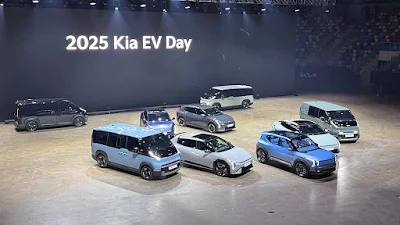Kia President and CEO Ho Sung Song isn’t too concerned with Chinese EVs. He believes that there’s space for them to coexist, at least for now. His comments come as Kia unveiled their expanded EV strategy at the 2025 Kia EV Day, their second global keynote that centers around the Korean automaker’s electrification strategy.
As Kia’s previous Head of Global Operations Division (he was head of Kia Motors Europe and Kia Motors’ Export Planning Group before that), Mr. Song knows what he’s talking about. His appointment in 2020 coincided with Kia’s “Plan S” strategy—one that wants to establish them as a progressive leader, particularly in the field of electric and even autonomous vehicles.
On the surface, China is a New Energy Vehicle (the collective term for BEVs, PHEVs, and HEVs) powerhouse with 12.87 million out of 16.07 million units sold worldwide ending up in the mainland. However, delve into the details and only 1.28 million went outside of China. This, Mr. Song says, shows that there’s space for established legacy auto brands like Kia and Chinese brands to coexist, especially outside China’s sphere of influence.
“We are not yet affected,” Mr. Song says when asked about the rise of Chinese NEV brands. “Everyone is still growing in terms of global market share.”
Mr. Song is also quick to point out that the plateauing sales in regions like Europe points to a new kind of customer, one that Kia aims to tap with their diversified EV strategy. The era of “Early Adopters” wowed by the likes of the EV6 and EV9 is now over, he says. Instead, it has shifted to the so-called “Early Majority” of the segment. This means a shift from technological-driven purchases to something that centers around practicality, and above all, accessibility. As such, the availability of choice becomes paramount.
“Kia remains committed to becoming the world’s leading EV brand and sustainable mobility solutions provider by enhancing the options and experiences we offer our customers,” he said. “We strive to democratize EV ownership, making the benefits of sustainable mobility solutions open to everyone.”
With that in mind, Kia, is flexing the capability of its dedicated E-GMP architecture shifting it from 800-volt, rear-drive first setup to a 400-volt front-drive setup. This allows them to create a small range of all-electric passenger vehicles such as the EV3, EV5, and the newly launched EV4, and upcoming EV2. They also announced their first-mover in the EV light commercial vehicle space with the PV5. The PV5 is the first vehicle that uses the new E-GMP.S (E-GMP for Service) platform.
Despite its diversified EV line-up, Mr. Song does admit they will never be able to compete against the Chinese brands price-wise. However, he says that Kia will continue to flaunt quality not just in terms of product, but in terms of serviceability as well. He says that their EVs are designed with high levels of repairability in mind, allowing them to diagnose and replace individual battery cells if needed. This is compared to their Chinese counterparts which typically don’t consider this in their vehicle design.


Finally what I been saying before, look at the figures BYD and other China brands only look big because they are dominating inside China. Outside China their sales are subpar. It like saying petron dominates the Philippine market over shell. But outside phil she'll is bigger.
ReplyDeleteEV2 and soon EV 1 could do battle vs china EV's
ReplyDeleteBYD numba one. Goodbye Toyota.
ReplyDeleteTesla mumber one goodbye BYD. Tesla very human design
ReplyDeleteBYD meaning Buy Your Demons
ReplyDelete